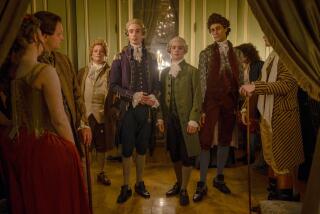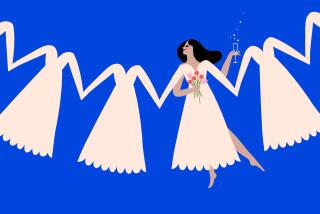Fear and Clothing at the Altar : Just This Once, Guys, You <i> Must</i> Obey the Rules
- Share via
Decked out in a white tux, bridegroom Adi Liberman stood slack-jawed before family and friends.
There were his groomsmen, impeccably attired in the prescribed black.
But then, like Rudolph among the regular reindeer, his best man showed up sporting a . . . gasp! . . . red cummerbund and bow tie.
“Did he have that approved?” someone whispered.
Liberman didn’t know how to react.
Already, the executive director of Heal the Bay, advocacy group for Santa Monica Bay, had compromised his fashion sensibility, forsaking his desire to be married in a traditional Jewish kittel for the black and white formality that wedding experts have proclaimed de rigueur.
But now his best man, his own brother, had chosen this moment to assert his contempt for fashion fascism.
Naturally, the wedding--and life--went on.
But Liberman’s dilemma exposes a tragic reality that for too long has been kept in the shadows: The male gender’s shaky relationship with fashion becomes doubly doubtful in respect to this most unsettling of modern rituals.
Thus the legions of self-sure wedding experts ready to save faltering bridegrooms from the socially debilitating fashion faux pas that lie hidden like cow patties at one of those ‘70s-style pastoral weddings.
But be warned: Even the experts, at least those who are male, tend to utter paradoxical absurdities. Listen, for example, to Michael Perry, author of “The Groom’s Survival Guide,” as he ruminates on wedding fashion: “Just because it’s silly doesn’t mean it’s not important.”
*
Current notions of wedding fashion, says Perry, “were all cooked up during the Victorian Era . . . . Evening jackets, tuxedos, all came into being then, and we’ve pretty much stayed with those variations. A wedding today would look a lot more like a 1880 wedding than an 1880 would look like an 1850 wedding.”
Despite the relative youth of the modern wedding, though, the authorities are unforgiving on matters of authority.
“There aren’t too many choices,” explains Barbara Tober, editor-in-chief of Bride’s and Your New Home.
Or as Jaclyn Barrett-Hirschhaut of Elegant Bride magazine puts it: “There’s not a lot of room for being excessively creative without making a social blunder.”
Which is not to say that advertisers don’t pump big bucks into making potential grooms think there’s plenty to decide.
Tober, whose February/March issue boasts 841 pages of advertisements directed at brides and grooms-- eight hundred and forty one !--says the significant differences are dictated by region and station.
“There are men who wear cowboy boots with tuxedos in Texas. . . . They dress far differently in Aspen than in Vail.”
Even in Texas, though, the boots had better be black or white or gray, because those are the only choices du jour, the wedding experts say.
The bride and bridesmaids may be as colorful as a box of crayons. “The groom will be harmonizing with that,” says Tober.
And groomsman harmony is always sotto voce.
Says Barrett-Hirschhaut: “I think the sophistication and elegance of shades of dark gray and black show a maturity that isn’t expressed with a pastel color. Powder-blue tuxedos--save those for the prom. The same can be said for pastel-colored accessories like bow ties and cummerbunds. They are not considered elegant for a wedding.”
Beyond that, the narrow range of acceptable choice centers on the time of the day, the authorities say.
“It’s simple,” says Barrett-Hirschhaut. “The type of attire that the male members of the wedding party choose is determined by the time and formality of the wedding.” (See accompanying chart, this page.)
Truly irrepressible--some would say reckless--fashion rebels might dare to go for a shawl collar on the formal wear. But, says Tober, “notched lapels are classic.”
Simple, huh? But still there are fashion flounderers.
For instance, “there seems to be a trend being proliferated by people at formal-wear specialty shops who don’t know better, to suggest that the groom wear one style and groomsmen wear something different,” sniffs Barrett-Hirschhaut.
“That could be a major social blunder to people who understand what social etiquette is.
“The groom may wear a different boutonniere,” she concedes. “But all the men of wedding party, from ushers to even the fathers and grandfathers, should wear identical formal wear.”
Not everyone takes the social etiquette so seriously.
Perry, author of the groom’s manual, is skeptical.
“It’s really important that this year’s fashions be different than last year’s--if you’re in the business of selling fashions,” he says. “They whip up brilliant reasons why it has to change. They’ll say, in all seriousness, that it’s societal evolution. Each year has weird prose (to justify) making these decisions. They’re always done really straight-faced, with tags like, ‘We’re maturing as a society.’
“There’s a secret cabal of designers who meet each year and decree that this year’s color is going to be white,” he says, in all seriousness. “They’re like the oracles at Delphi. They’re answerable to nobody. . . . They really do meet each year, make recommendations to textile and fashion industry, and everyone follows what they do. They have these decisions all stored. Look back at 1973, it was probably mustard colors. In 1984, tuxes were probably all magenta--’Miami Vice’ colors.
“Their aesthetic whims may as well be law,” he continues. “This is upsetting to grooms sometimes, who say, ‘I have an old suit. How come I have to follow the dictates of fashion?”’
Perry has pondered just that issue.
“This is not a new question,” he says. “Thomas Jefferson said, ‘In matters of principle, stand like a rock; in matters of taste, swim with the current.’ ”
Most grooms seem comfortable with that approach.
Roland Poindexter, manager of development at Nelvana Entertainment, plans to wed teacher Toni Klugh in October.
“My role would be best described as controller,” he says. “I’m trying to control costs. Trying to control the style. I don’t want anything too elaborate.”
He says that he’ll wear a black tux--”extremely simple and streamlined”--with just a touch of individual flair: “We’re African-American. So we may have an African-American-style tie and cummerbund.”
But really, he’s not going to get worked up about things one way or the other, his casual tone suggests.
“If any women read this they’re going to hate my guts, but to me a wedding is just a legal formality. If I’m in love enough with someone to want to marry them, that’s enough for me. I’d rather concentrate on our relationship and making it last as long as possible, which is hopefully the rest of our lives.”
Liberman of the red-cummerbund affair takes a similar view.
“It always troubles me to be out of step with general sensibilities . . . . But in the end, I was so out of it that night, it probably wouldn’t have mattered what I wore. I was cold sober, but the whole evening was like a dream sequence. I barely remember anything after the photos were taken. The only strong recollection is what I’ve seen in videotape of the affair.
“I plan on staying married,” he says.
But . . .
“If there is a next time, I’ll be older and more mature, so I’ll probably wear Levi’s Dockers. I’m sure they’ll come out with a wedding line by then.”
A Dressing Guide for the Groom
Formal Evening: After 6 p.m. (Year-round)
COAT: Tailcoat (full dress)
COLOR: Black
TROUSERS: To match coat
VEST: White pique waistcoat
SHIRT: White pique bosom
COLLAR: Wing (separate) or attached
TIE: White bow
JEWELRY: White or pearl studs and links
SHOES: Patent pumps or oxfords
HOSE: Black silk, lisle or nylon
OVERCOAT: Black dress coat
Semiformal Evening: After 6 p.m. (September-May)
COAT: Formal separate dinner jacket or tuxedo
COLOR: Black or subdued colors to coordinate
TROUSERS: To match or coordinate with coat
VEST: Matching or coordinated vest
SHIRT: Pleated or fancy bosom in white or colors
COLLAR: Attached turndown or wing collar
TIE: Black or to match shirt, vest or satin facings. Patterned or solid ascot
JEWELRY: Black, gold or jeweled studs and links
SHOES: Patent or polished calf dress shoes
HOSE: Black silk, lisle or nylon
OVERCOAT: Black single- or double-breasted coat
Semiformal Evening: After 6 p.m. (May-September)
COAT: Dinner jacket or tuxedo
COLOR: White, pastels, vibrant colors
TROUSERS: Black, or to match or coordinate with coat
VEST: Plain or matching vest
SHIRT: Pleated or fancy bosom in white or colors
COLLAR: Attached turndown or wing collar
TIE: Black or to match shirt or vest. Patterned or solid ascot
JEWELRY: Black, gold or jeweled studs and links
SHOES: Patent or polished calf dress shoes
HOSE: Black silk, lisle or nylon
OVERCOAT: None
Formal Daytime: Before 6 p.m. (Year-round)
COAT: Tuxedo, ascot or class cutaway
COLOR: The color of your choice
TROUSERS: Matching, coordinating or classic stripe (with cutaway)
VEST: Matching or coordinating vest
SHIRT: Your choice--plain or white--white or colors
COLLAR: Wing or attached turndown collar
TIE: Color-coordinated bow or striped or solid ascot
JEWELRY: Pearl or jeweled stickpin with ascot
SHOES: Polished calf dress shoes
HOSE: Black silk, lisle or nylon
OVERCOAT: Black or oxford gray Chesterfield
Semiformal Daytime: Before 6 p.m. (Year-round)
COAT: Classic stroller or the tuxedo of your choice
COLOR: Gray (stroller) or color of your choice (tux)
TROUSERS: Matching, coordinating or Classic Stripe
VEST: Matching or coordinating vest
SHIRT: Your choice--plain or fancy--white or colors
COLLAR: Wing or attached turndown collar
TIE: Color-coordinated bow or striped or solid ascot or four-in-hand
JEWELRY: Black, gold or jeweled studs and links
SHOES: Polished calf dress shoes
HOSE: Black silk, lisle or nylon
OVERCOAT: Black or oxford gray Chesterfield
Source: “The Groom’s Survival Manual” by Michael R. Perry, 1991 by Michael R. Perry. Reprinted by permission of Pocket Books.






